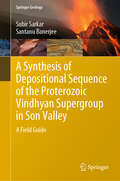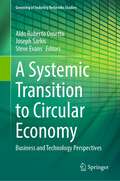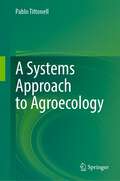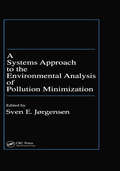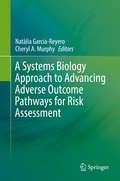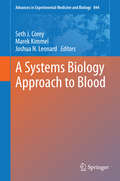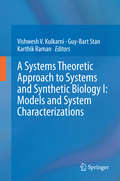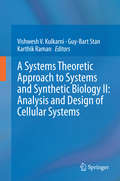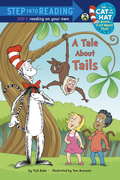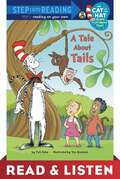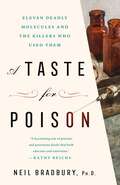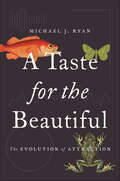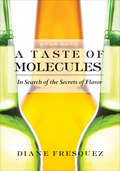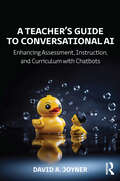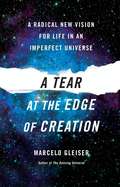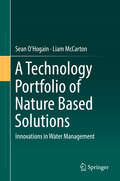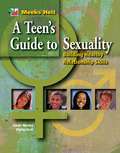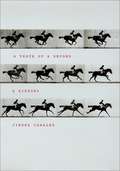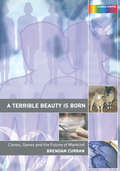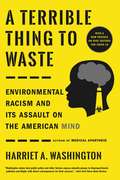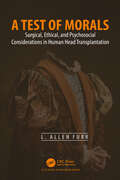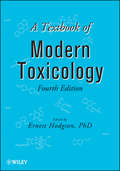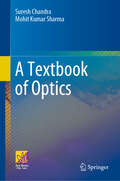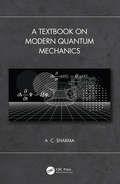- Table View
- List View
A Synthesis of Depositional Sequence of the Proterozoic Vindhyan Supergroup in Son Valley: A Field Guide (Springer Geology)
by Santanu Banerjee Subir SarkarThis book offers extensive information on the course of sedimentation in the Proterozoic Vindhyan Basin and the potential record of ancient life stored within the rocks. It covers topics ranging from facies analysis to sequence-building, from carbonates to siliciclastics, and mixed lithology and life records from microbial to potentially eukaryotes, along with the basin evolutionary history. Further, the book includes 75 color photographs and accompanying hand-sketches to help readers grasp key aspects of Vindhyan Geology. Vindhyan rocks are well known for their excellent preservation of microbial record of earth. Offering a student-friendly field guide containing detailed route maps, geological maps and a wealth of visual examples, it is also extremely useful in terms of understanding the microbe-dominated environments on Mars.
A Systemic Transition to Circular Economy: Business and Technology Perspectives (Greening of Industry Networks Studies #12)
by Steve Evans Joseph Sarkis Aldo Roberto OmettoThe book will explore, using multiple perspectives from multiple contributors, two main aspects for circular economy (CE) business and technology (B&T): systems and value perspectives. Going beyond a linear-economic perspective--the traditional perspective--CE needs to develop intentional and integrated paths to help restore physical resources and regenerate the functions of natural and anthropic systems, creating greater economic and social opportunities, with environmentally positive outcomes. Whether this is feasible and possible within the context of CE and B&T is something that will be central to the contributions made in this book. A major objective of the book is to deliver practical and fundamental knowledge of B&T CE insights combining a systems perspective and value creation for socio-technical innovation leading to sustainable transitions and effective transformations. Based on those key aspects, the book is structured in two parts, one from a more theoretical and conceptual basis in Part 1, and a more applied perspective in Part 2. The chapters in Part 1 are presented through the lens of business and systems transitions. In Part 2, the chapters present the opportunities and the journeys from real case studies of companies engaged in circular business strategies, processes, practices, and technologies.
A Systems Approach to Agroecology
by Pablo TittonellAs agroecology gains momentum in the international research-for-development arena, there is an urgent need for methods and tools to support the codesign and evaluation of agroecological systems and their transitions. The social and ecological complexity of agroecosystems, their dynamics, uncertainties and sustainability, calls for a holistic, systemic approach to agroecology. As such, several questions arise for example: how do we deal with heterogeneity, landscapes, biodiversity or learning processes in agroecosystems analysis? How do we categorise diversity or analyse trade-offs in social-ecological interactions? How do we conceptualise, codesign and monitor agroecological transitions? This book sets out to answer these questions by building on the valuable ‘classics’ in agroecology. The book presents a systems perspective that underpins a combination of methodologies, ranging from participatory tools and field observations to mathematical simulation modelling. Researchers, advanced students and transdisciplinary practitioners will find in this book insights and methods to design research and (co-) innovation processes to foster agroecological transitions.
A Systems Approach to the Environmental Analysis of Pollution Minimization
by Sven E. JorgensenThe environmental analysis of pollution problems always involves the use of mass and energy balances to quantify the extent of pollution and its sources. This same form of analysis can be applied to ecosystems, production systems, a whole country or a region. A Systems Approach to the Environmental Analysis of Pollution Minimization identifies and describes the common factors shared by these systems.The book is organized in twelve chapters and progresses from general concepts to specific assessment methods. Chapter one is a general introduction to environmental management principles. Chapter two discusses conservation principles and their applications to environmental health. Chapters three and four explore ecosystem health, properties and analysis. Chapters five through eleven present different methods of analysis including Green Accounting, Clean Technology, Life Cycle Analysis, and Risk Assessment. Editor Sven Jorgensen closes the book with a sweeping summary. Jorgensen is a internationally published authority on the use and analysis of ecosystem models. His new book is a comprehensive guide for both students and professionals. A Systems Approach to the Environmental Analysis of Pollution Minimization is an invaluable contribution.Features
A Systems Biology Approach to Advancing Adverse Outcome Pathways for Risk Assessment
by Natàlia Garcia-Reyero Cheryl A. MurphySocial pressure to minimize the use of animal testing, the ever-increasing concern on animal welfare, and the need for more human-relevant and more predictive toxicity tests are some of the drivers for new approaches to chemical screening. This book focuses on The Adverse Outcome Pathway, an analytical construct that describes a sequential chain of causally linked events at different levels of biological organization that lead to an adverse health or ecotoxicological effect. While past efforts have focused on toxicological pathway-based vision for human and ecological health assessment relying on in vitro systems and predictive models, The Adverse Outcome Pathway framework provides a simplified and structured way to organize toxicological information. Within the book, a systems biology approach supplies the tools to infer, link, and quantify the molecular initiating events and the key events and key event relationships leading to adverse outcomes. The advancement of these tools is crucial for the successful implementation of AOPs for regulatory purposes.
A Systems Biology Approach to Blood (Advances in Experimental Medicine and Biology #844)
by Marek Kimmel Seth Joel Corey Joshua N. LeonardThe blood system is multi-scale, from the organism to the organs to cells to intracellular signaling pathways to macromolecule interactions. Blood consists of circulating cells, cellular fragments (platelets and microparticles), and plasma macromolecules. Blood cells and their fragments result from a highly-ordered process, hematopoiesis. Definitive hematopoiesis occurs in the bone marrow, where pluripotential stem cells give rise to multiple lineages of highly specialized cells. Highly-productive and continuously regenerative, hematopoiesis requires a microenvironment of mesenchymal cells and blood vessels. A Systems Biology Approach to Blood is divided into three main sections: basic components, physiological processes, and clinical applications. Using blood as a window, one can study health and disease through this unique tool box with reactive biological fluids that mirrors the prevailing hemodynamics of the vessel walls and the various blood cell types. Many blood diseases, rare and common can and have been exploited using systems biology approaches with successful results and therefore ideal models for systems medicine. More importantly, hematopoiesis offers one of the best studied systems with insight into stem cell biology, cellular interaction, development; linage programing and reprograming that are every day influenced by the most mature and understood regulatory networks.
A Systems Theoretic Approach to Systems and Synthetic Biology I: Models And System Characterizations
by Vishwesh V. Kulkarni Guy-Bart Stan Karthik RamanThe complexity of biological systems has intrigued scientists from many disciplines and has given birth to the highly influential field of systems biology wherein a wide array of mathematical techniques, such as flux balance analysis, and technology platforms, such as next generation sequencing, is used to understand, elucidate, and predict the functions of complex biological systems. More recently, the field of synthetic biology, i. e. , de novo engineering of biological systems, has emerged. Scientists from various fields are focusing on how to render this engineering process more predictable, reliable, scalable, affordable, and easy. Systems and control theory is a branch of engineering and applied sciences that rigorously deals with the complexities and uncertainties of interconnected systems with the objective of characterising fundamental systemic properties such as stability, robustness, communication capacity, and other performance metrics. Systems and control theory also strives to offer concepts and methods that facilitate the design of systems with rigorous guarantees on these properties. Over the last 100 years, it has made stellar theoretical and technological contributions in diverse fields such as aerospace, telecommunication, storage, automotive, power systems, and others. Can it have, or evolve to have, a similar impact in biology? The chapters in this book demonstrate that, indeed, systems and control theoretic concepts and techniques can have a significant impact in systems and synthetic biology. Volume I provides a panoramic view that illustrates the potential of such mathematical methods in systems and synthetic biology. Recent advances in systems and synthetic biology have clearly demonstrated the benefits of a rigorous and systematic approach rooted in the principles of systems and control theory - not only does it lead to exciting insights and discoveries but it also reduces the inordinately lengthy trial-and-error process of wet-lab experimentation, thereby facilitating significant savings in human and financial resources. In Volume I, some of the leading researchers in the field of systems and synthetic biology demonstrate how systems and control theoretic concepts and techniques can be useful, or should evolve to be useful, in order to understand how biological systems function. As the eminent computer scientist Donald Knuth put it, "biology easily has 500 years of exciting problems to work on". This edited book presents but a small fraction of those for the benefit of (1) systems and control theorists interested in molecular and cellular biology and (2) biologists interested in rigorous modelling, analysis and control of biological systems.
A Systems Theoretic Approach to Systems and Synthetic Biology II: Analysis And Design Of Cellular Systems
by Vishwesh V. Kulkarni Guy-Bart Stan Karthik RamanThe complexity of biological systems has intrigued scientists from many disciplines and has given birth to the highly influential field of systems biology wherein a wide array of mathematical techniques, such as flux balance analysis, and technology platforms, such as next generation sequencing, is used to understand, elucidate, and predict the functions of complex biological systems. More recently, the field of synthetic biology, i. e. , de novo engineering of biological systems, has emerged. Scientists from various fields are focusing on how to render this engineering process more predictable, reliable, scalable, affordable, and easy. Systems and control theory is a branch of engineering and applied sciences that rigorously deals with the complexities and uncertainties of interconnected systems with the objective of characterising fundamental systemic properties such as stability, robustness, communication capacity, and other performance metrics. Systems and control theory also strives to offer concepts and methods that facilitate the design of systems with rigorous guarantees on these properties. Over the last 100 years, it has made stellar theoretical and technological contributions in diverse fields such as aerospace, telecommunication, storage, automotive, power systems, and others. Can it have, or evolve to have, a similar impact in biology? The chapters in this book demonstrate that, indeed, systems and control theoretic concepts and techniques can have a significant impact in systems and synthetic biology. Volume II contains chapters contributed by leading researchers in the field of systems and synthetic biology that concern modeling physiological processes and bottom-up constructions of scalable biological systems. The modeling problems include characterisation and synthesis of memory, understanding how homoeostasis is maintained in the face of shocks and relatively gradual perturbations, understanding the functioning and robustness of biological clocks such as those at the core of circadian rhythms, and understanding how the cell cycles can be regulated, among others. Some of the bottom-up construction problems investigated in Volume II are as follows: How should biomacromolecules, platforms, and scalable architectures be chosen and synthesised in order to build programmable de novo biological systems? What are the types of constrained optimisation problems encountered in this process and how can these be solved efficiently? As the eminent computer scientist Donald Knuth put it, "biology easily has 500 years of exciting problems to work on". This edited book presents but a small fraction of those for the benefit of (1) systems and control theorists interested in molecular and cellular biology and (2) biologists interested in rigorous modelling, analysis and control of biological systems.
A Tale About Tails (Step into Reading)
by Tom Brannon Tish RabeStep into reading with the Cat in the Hat in this leveled reader about animal tails based on an episode of the hit PBS Kids television show The Cat in the Hat Knows a Lot About That! While playing Pin the Tail on the Donkey, Sally and Nick get to wondering: What would it be like to have a tail of their own? And how would you pick the best one? Enter the Cat in the Hat. To help the kids choose, he whisks them off to the jungle to see--and try on--a variety of tails that serve different purposes: A monkey's tail that is strong for holding onto branches; a quetzal's tail that is long and colorful for attracting a mate; and a rattlesnake's tail that makes sound as a warning. Written for children who are ready to read independently, this tale about tails is a fun, funny book that introduces kids to basic comparitive anatomy!
A Tale About Tails (Step into Reading)
by Tish RabeStep into reading with the Cat in the Hat in this leveled reader about animal tails based on an episode of the hit PBS Kids television show The Cat in the Hat Knows a Lot About That! While playing Pin the Tail on the Donkey, Sally and Nick get to wondering: What would it be like to have a tail of their own? And how would you pick the best one? Enter the Cat in the Hat. To help the kids choose, he whisks them off to the jungle to see—and try on—a variety of tails that serve different purposes: A monkey's tail that is strong for holding onto branches; a quetzal's tail that is long and colorful for attracting a mate; and a rattlesnake's tail that makes sound as a warning. Written for children who are ready to read independently, this tale about tails is a fun, funny book that introduces kids to basic comparitive anatomy! This Read & Listen Edition contains audio narration.
A Taste for Poison: Eleven Deadly Molecules and the Killers Who Used Them
by Neil Bradbury“A fascinating tale of poisons and poisonous deeds which both educates and entertains.” --Kathy ReichsA brilliant blend of science and crime, A TASTE FOR POISON reveals how eleven notorious poisons affect the body--through the murders in which they were used. As any reader of murder mysteries can tell you, poison is one of the most enduring—and popular—weapons of choice for a scheming murderer. It can be slipped into a drink, smeared onto the tip of an arrow or the handle of a door, even filtered through the air we breathe. But how exactly do these poisons work to break our bodies down, and what can we learn from the damage they inflict? In a fascinating blend of popular science, medical history, and true crime, Dr. Neil Bradbury explores this most morbidly captivating method of murder from a cellular level. Alongside real-life accounts of murderers and their crimes—some notorious, some forgotten, some still unsolved—are the equally compelling stories of the poisons involved: eleven molecules of death that work their way through the human body and, paradoxically, illuminate the way in which our bodies function. Drawn from historical records and current news headlines, A Taste for Poison weaves together the tales of spurned lovers, shady scientists, medical professionals and political assassins to show how the precise systems of the body can be impaired to lethal effect through the use of poison. From the deadly origins of the gin & tonic cocktail to the arsenic-laced wallpaper in Napoleon’s bedroom, A Taste for Poison leads readers on a riveting tour of the intricate, complex systems that keep us alive—or don’t.
A Taste for the Beautiful: The Evolution of Attraction
by Michael J. RyanFrom one of the world's leading authorities on animal behavior, the astonishing story of how the female brain drives the evolution of beauty in animals and humansDarwin developed the theory of sexual selection to explain why the animal world abounds in stunning beauty, from the brilliant colors of butterflies and fishes to the songs of birds and frogs. He argued that animals have “a taste for the beautiful” that drives their potential mates to evolve features that make them more sexually attractive and reproductively successful. But if Darwin explained why sexual beauty evolved in animals, he struggled to understand how. In A Taste for the Beautiful, Michael Ryan, one of the world’s leading authorities on animal behavior, tells the remarkable story of how he and other scientists have taken up where Darwin left off and transformed our understanding of sexual selection, shedding new light on human behavior in the process.Drawing on cutting-edge work in neuroscience and evolutionary biology, as well as his own important studies of the tiny Túngara frog deep in the jungles of Panama, Ryan explores the key questions: Why do animals perceive certain traits as beautiful and others not? Do animals have an inherent sexual aesthetic and, if so, where is it rooted? Ryan argues that the answers to these questions lie in the brain—particularly of females, who act as biological puppeteers, spurring the development of beautiful traits in males. This theory of how sexual beauty evolves explains its astonishing diversity and provides new insights about the degree to which our own perception of beauty resembles that of other animals.Vividly written and filled with fascinating stories, A Taste for the Beautiful will change how you think about beauty and attraction.
A Taste of Molecules: In Search of the Secrets of Flavor (Women Writing Science Ser.)
by Diane FresquezA delicious exploration of what creates the flavors we love—and why our taste buds respond to them—in a fascinating, &“very pleasant and easy read&” (Flanders Today). In this unique scientific study of food, drink, and how the human taste buds sense taste, food journalist Diane Fresquez brings readers along on a journey of gastronomic discovery. She begins by following a Belgian beekeeper who uses science to give the ancient drink of mead (or &“honey wine&”) a modern taste-makeover. Fresquez then travels to Holland to learn how food memories are tested at a research center called the Restaurant of the Future. And elsewhere, she discovers how much skill it takes to make banana flavor in the lab, and experiments on a group of scientists during a surprise meal eaten in the dark. Stuffed with fascinating food facts, anecdotes from the author&’s own culinary life, and a selection of irresistible recipes (including a cocktail with dancing molecules), A Taste of Molecules is an exploration of the senses that will delight foodies and science enthusiasts alike.
A Teacher's Guide to Using the Next Generation Science Standards with Gifted and Advanced Learners
by Cheryll Adams Alicia Cotabish Debbie DaileyA Teacher's Guide to Using the Next Generation Science Standards With Gifted and Advanced Learners provides teachers and administrators with practical examples of ways to build comprehensive, coherent, and rigorous science learning experiences for gifted and advanced students from kindergarten to high school. It provides an array of examples across the four domains of science: physical sciences; Earth and space sciences; life sciences; and engineering, technology, and applications of science. Each learning experience indicates the performance expectation addressed and includes a sequence of activities, implementation examples, connections to the CCSS-Math and CCSS-ELA, and formative assessments. Chapters on specific instructional and management strategies, assessment, and professional development suggestions for implementing the standards within the classroom will be helpful for both teachers and administrators.
A Teacher’s Guide to Conversational AI: Enhancing Assessment, Instruction, and Curriculum with Chatbots
by David A. JoynerA Teacher’s Guide to Conversational AI explores the practical role that language-based artificial intelligence tools play in classroom teaching, learning experiences, and student assessment. Today’s educators are well aware that conversational and generative AI—chatbots, intelligent tutoring systems, large language models, and more—represent a complex new factor in teaching and learning. This introductory primer offers comprehensive, novice-friendly guidance into the challenges and opportunities of incorporating AI into K-12 schools and college classes in ways that are appropriate, nourishing to students, and outcomes-driven.Opening with an informative overview of the foundational properties, key terminology, and ethical considerations of these tools, the book offers a coherent and realistic vision of classrooms that are enhanced, rather than stymied, by AI systems. This includes strategies for:· designing assessments that are conducive to students’ beneficial use of AI while mitigating overreliance or dishonesty;· using AI to generate lesson examples for student critique or custom content that reinforces course principles;· leveraging chatbots as a co-instructor or a tutor, a guide during student-driven learning, a virtual debate or brainstorming partner, and a design project; and· creating course content, lesson plans and activities, expanded language and accessibility options, and beyond. Through the depth of understanding and applied approach provided in these chapters, teachers and leaders in training and in service, alongside private tutors, college instructors, and other educators, will be better prepared to future-proof their efforts to serve new generations of learners.
A Tear at the Edge of Creation: A Radical New Vision for Life in an Imperfect Universe
by Marcelo GleiserFor millennia, shamans and philosophers, believers and nonbelievers, artists and scientists have tried to make sense of our existence by suggesting that everything is connected, that a mysterious Oneness binds us to everything else. People go to temples, churches, mosques, and synagogues to pray to their divine incarnation of Oneness. Following a surprisingly similar notion, scientists have long asserted that under Nature's apparent complexity there is a simpler underlying reality. In its modern incarnation, this Theory of Everything would unite the physical laws governing very large bodies (Einstein's theory of relativity) and those governing tiny ones (quantum mechanics) into a single framework. But despite the brave efforts of many powerful minds, the Theory of Everything remains elusive. It turns out that the universe is not elegant. It is gloriously messy. Overturning more than twenty-five centuries of scientific thought, award-winning physicist Marcelo Gleiser argues that this quest for a Theory of Everything is fundamentally misguided, and he explains the volcanic implications this ideological shift has for humankind. All the evidence points to a scenario in which everything emerges from fundamental imperfections, primordial asymmetries in matter and time, cataclysmic accidents in Earth's early life, and duplication errors in the genetic code. Imbalance spurs creation. Without asymmetries and imperfections, the universe would be filled with nothing but smooth radiation. A Tear at the Edge of Creation calls for nothing less than a new "humancentrism" to reflect our position in the universal order. All life, but intelligent life in particular, is a rare and precious accident. Our presence here has no meaning outside of itself, but it does have meaning. The unplanned complexity of humankind is all the more beautiful for its improbability. It's time for science to let go of the old aesthetic that labels perfection beautiful and holds that "beauty is truth. " It's time to look at the evidence without centuries of monotheistic baggage. In this lucid, down-to-earth narrative, Gleiser walks us through the basic and cutting-edge science that fueled his own transformation from unifier to doubter--a fascinating scientific quest that led him to a new understanding of what it is to be human.
A Technology Portfolio of Nature Based Solutions: Innovations In Water Management
by Sean O'Hogain Liam McCartonThis book aims to define the concept of Nature Based Solutions (NBS) by using case studies from members of the European Innovation Partnership (EIP) Water Action Group - NatureWat. NBS is defined and characterized in terms of water source, contaminants, removal mechanisms and resource recovery potential. The case studies presented illustrate the appropriateness of NBS promoting climate resilience. Readers will discover a technology portfolio based on a number of demonstration sites in the fields of climate change adaption, water and wastewater treatment, resource recovery and re-use, and restoring ecosystems to promote the use of nature based solutions. The chapters in the book present a multidisciplinary approach involving social scientists, governance representatives and engineers. The underlying philosophy of the book is the circular economy of water which prioritizes the concepts of resource recovery and resilience within water resource management. The first section of the book presents the background and objectives of the study, and how the action group aims to promote the use of nature based solutions through its diverse technology portfolio. Particular attention is given to the goals of finding cost-effective solutions for wastewater treatment, climate change mitigation, disaster risk reduction, flood protection, greening cities, degraded areas restoration and biodiversity preservation. The chapter on reclaimed water addresses water reuse and defines the term fit for purpose. Barriers and limitations related to NBS for water resource management are discussed. The book concludes with several case studies at local, regional and global levels which illustrate a new approach to water management. These case studies illustrate the application of a hybrid green and grey infrastructure system. This is a combination of traditional engineered infrastructure with nature based solutions which combines centralised and decentralised systems to optimise the reclamation of water for reuse in a fit for purpose model.
A Teen's Guide to Sexuality: Building Healthy Relationship Skills
by Linda Meeks Philip HeitRelationships are the connections that people have with each other. The quality of your relationships affects your well-being. Inspiriting relationships are relationships that lift the spirit and contribute to a sense of well-being.
A Tenth of a Second: A History
by Jimena CanalesIn the late fifteenth century, clocks acquired minute hands. A century later, second hands appeared. But it wasn't until the 1850s that instruments could recognize a tenth of a second, and, once they did, the impact on modern science and society was profound. Revealing the history behind this infinitesimal interval, A Tenth of a Second sheds new light on modernity and illuminates the work of important thinkers of the last two centuries. Tracing debates about the nature of time, causality, and free will, as well as the introduction of modern technologies--telegraphy, photography, cinematography--Jimena Canales locates the reverberations of this "perceptual moment" throughout culture. Once scientists associated the the tenth of a second with the speed of thought, they developed reaction time experiments with lasting implications for experimental psychology, physiology, and optics. Astronomers and physicists struggled to control the profound consequences of results that were a tenth of a second off. And references to the interval were part of a general inquiry into time, consciousness, and sensory experience that involved rethinking the contributions of Descartes and Kant. Considering its impact on much longer time periods and featuring appearances by Henri Bergson, Walter Benjamin, and Albert Einstein, among others, A Tenth of a Second is ultimately an important contribution to history and a novel perspective on modernity.
A Terrible Beauty is Born: Clones, Genes and the Future of Mankind (Science Spectra Ser.)
by Brendan CurranGenetics and its related technologies are revolutionizing the world. The media is regularly dominated by controversy over the latest genetically modified (GM) food, human gene therapy or cancer chip technology. Maverick scientists are in the process of cloning humans, and the human genome sequence is available on the Internet. Fifty years ago we di
A Terrible Thing to Waste: Environmental Racism and Its Assault on the American Mind
by Harriet Washington<P><P>Did you know...Middle-class African American households with incomes between $50,000 and $60,000 live in neighborhoods that are more polluted than those of very poor white households with incomes below $10,000. <P><P>When swallowed, a lead-paint chip no larger than a fingernail can send a toddler into a coma -- one-tenth of that amount will lower his IQ. <P><P>Nearly two of every five African American homes in Baltimore are plagued by lead-based paint. Almost all of the 37,500 Baltimore children who suffered lead poisoning between 2003 and 2015 were African American.From injuries caused by lead poisoning to the devastating effects of atmospheric pollution, infectious disease, and industrial waste, Americans of color are harmed by environmental hazards in staggeringly disproportionate numbers. <P><P>This systemic onslaught of toxic exposure and institutional negligence causes irreparable physical harm to millions of people across the country-cutting lives tragically short and needlessly burdening our health care system. But these deadly environments create another insidious and often overlooked consequence: robbing communities of color, and America as a whole, of intellectual power. <P><P>The 1994 publication of The Bell Curve and its controversial thesis catapulted the topic of genetic racial differences in IQ to the forefront of a renewed and heated debate. <P><P>Now, in A Terrible Thing to Waste, award-winning science writer Harriet A. Washington adds her incisive analysis to the fray, arguing that IQ is a biased and flawed metric, but that it is useful for tracking cognitive damage. <P><P>She takes apart the spurious notion of intelligence as an inherited trait, using copious data that instead point to a different cause of the reported African American-white IQ gap: environmental racism - a confluence of racism and other institutional factors that relegate marginalized communities to living and working near sites of toxic waste, pollution, and insufficient sanitation services. <P><P>She investigates heavy metals, neurotoxins, deficient prenatal care, bad nutrition, and even pathogens as chief agents influencing intelligence to explain why communities of color are disproportionately affected -- and what can be done to remedy this devastating problem. Featuring extensive scientific research and Washington's sharp, lively reporting, A Terrible Thing to Waste is sure to outrage, transform the conversation, and inspire debate.
A Test of Morals: Surgical, Ethical, and Psychosocial Considerations in Human Head Transplantation
by L. Allen FurrWhile transplanting human heads is not a new concept, the idea has largely been relegated to religious lore or as a plot device in science fiction. But now, a surgical plan to perform the complex procedure exists, and though most physicians question head transplantation’s medical veracity, bioethicists have challenged the surgery on moral grounds. A Test of Morals compiles and examines the ethical questions that dog those who advocate for conducting this most radical of medical proposals in order to determine if society should move forward and allow head transplantation to occur. Current bioethical principles stand in opposition to head transplantation, causing a conflict of values rarely seen in medicine.
A Textbook of Modern Toxicology
by Ernest HodgsonA Textbook of Modern Toxicology is a unique resource that provides both students and practitioners with a wide-ranging, accessible overview of the discipline. Suitable for courses in environmental, pharmacological, medical, and veterinary toxicology, this essential text features chapters written by experts who address a range of key topics.The Fourth Edition includes additional chapters on new approaches to toxicology - molecular methods (-omics: toxicogenomics, proteomics, and metabolomics), bioinformatics, and systems biology - and continues the legacy of its predecessors to provide up-to-date insights into acute toxicity and chemical carcinogenesis, organ toxicity, in vitro and in vivo toxicity testing, ecological risk assessment, and many other areas of toxicology that help foster a solid comprehension of the field.Also featured in the Fourth Edition are end-of-chapter questions and a Solutions Manual available separately for academic adopters.
A Textbook of Optics
by Suresh Chandra Mohit Kumar SharmaThis book is designed to serve as a textbook for courses offered to upper-undergraduate students enrolled in physics and explains the broad spectrum of optics in a student-friendly way. The textbook covers the entire syllabi of the undergraduate courses being taught at both national and international universities including adequate details of mathematical expressions to help students understand the subject matter. The topics covered in this book are reflection, refraction, cardinal points, interference, Fresnel diffraction, Fraunhofer diffraction, lasers and holography, fiber optics, etc. This book explains each topic in a simple and lucid language with the help of solved problems. Exercises with multiple choice questions have been given at the end of each chapter for self-assessment. The detailed coverage and pedagogical tools make this an ideal textbook for students and researchers enrolled in senior undergraduate and beginning postgraduate physics students.
A Textbook on Modern Quantum Mechanics
by A C SharmaOver the course of the past two to three decades, new tools of presentation and mathematical treatment have emerged and the subject matter of quantum mechanics has gone through significant changes. A Textbook on Modern Quantum Mechanics presents the selected elementary, intermediate, and advance topics with rejuvenated approach to the subject matter. Newly merged topics from contemporary physics and chemistry are included in the text as well as solved examples. The book covers: (i) fundamental discoveries that are the foundation of modern quantum mechanics; (ii) solution of Schrödinger’s wave equation for 1D problems and their importance; (iii) matrix and vector formulation of quantum mechanics; (iv) transformations, symmetries, and conservation laws; (v) angular and spin momenta; (vi) solution of Schrödinger equation for central potentials; (vii) time-independent perturbation theory, variational method and WKB approximation; (viii) quantum theory of scattering; (xi) many-particle systems and their quantum mechanical treatments; (x) time-dependent perturbations and the interaction of fields with matter; (xi) relativistic quantum mechanics; and (xii) quantization of fields and the second quantization. Key Features: It provides everything a student needs to know for succeeding at all levels of the undergraduate and graduate studies. It covers most of the topics that are taught under (a) elementary, (b) intermediate, and (c) advance courses of quantum mechanics at universities and colleges. It has detailed and elegant mathematical treatment with contemporary style of interpretation and presentation in simple English. Solved examples and unsolved exercises that are part of each chapter to consolidate the readers' understanding of fundamental concepts. The subject matter of the book is well tested on the students taught by the author over a period of 30 years. This is a valuable textbook for students pursuing Bachelor of Science, Master of Science, and Doctor of Philosophy (PhD) degrees in the subjects of Physics, Chemistry, and materials science in India, South Asian countries, the United States, and Europe.
